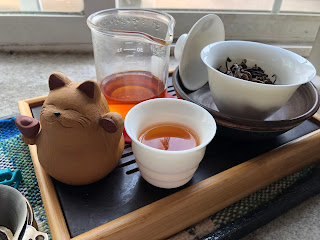Tea Session: Lady Orchid Ginseng Oolong
I've seen ginseng oolongs on various tea forums as people post asking questions about them, but this is the first time I've actually had a chance to try this particular tea. It's something that I wouldn't purchase for myself, but it was part of my Teaphile tea subscription and I am happy for a chance to now try this tea out.
According to Teaphile:
"Lady Orchid is a style of ginseng oolong; this name became official in 1998 as an effort to distinguish the level of craft and material from other ginseng oolong teas. Generally, a lightly oxidized greener style of oolong is used.....Lady Orchid uses a Tieguanyin oolong leaves and is blended with a mix of ginseng grown in Hainan Province and Wisconsin, licorice, and osmanthus."
I also looked online for other descriptions for this tea, and the descriptions are very similar with teas being grown in different regions from Anxi to Yunnan.. I searched under "Lan Gui Ren", which is another name for this particular tea. It produced some other results, but the descriptions are similar enough to what I've found elsewhere.
Tea Session Information
Here's the information about my tea session:
- Teaware: 110 ml Gaiwan
- Water Amount: ~ 100 ml
- Tea Amount: 4.96 grams. The tea leaves look like pellets covered in a fine powder. It doesn't really look like the tea I am used to drinking.
- Brewing Temperatures: 202 - 208 F
- Time: 15 seconds, increasing by 15 (i.e 15, 30, 45, etc)
- High notes of the aroma: Ginseng, flowers, savory
- Low notes of the aroma: dried candied fruit .. like dried ginger or ginseng.
- Leaves: The leaves took about 3-4 steeps to somewhat open from their pellet shape into actual leaves.
Figure: First 3-steeps of leaves opening
- Broth: The color of the broth ranges from a clear light orange to an amber with each steep. There is hardly any astringency or bitterness to any of the steeps
- First infusion: it's light, slightly floral, with notes of ginseng. It's a very crisp and smooth broth
- Second infusion: Smooth, velvety broth. It's still slightly floral & notes of ginseng. I'm getting a "hot" aftertaste of gingseng/ginger. It's not unpleasant.
- Third infusion: Surprisingly, I'm getting more ginseng notes here. The broth is still fairly smooth and crisp. I taste undercurrents of the TGY, but it's subtle.
- Fourth infusion: Similar to the 3rd, but now the flavor is starting to diminish slightly.
Figure: Color of the Tea Broth: #1, 3, 4 (The 2nd steep photo was unusable)
Summary
Overall, this isn't a bad tea at all, but it also doesn't taste like "tea" to me in the traditional sense. The ginseng notes are first and foremost in this tea. The tea soup is somewhat floral in nature, but it's not overpowering. There's the sweet element, which might be the osmanthus or the Tieguanyin that serves as the base. Luckily, I really can't taste the licorice (as I dislike the taste of licorice)As someone unfamiliar with ginseng teas, I found this very pleasant. It is not something that I would have normally purchased for myself, so I am glad for its inclusion in the Teaphile subscription box. As I've mentioned in this post, the subscription boxes give me a chance to try teas I would not have normally chosen, thus helping me to widen my tea repertoire.
As a side note, I am glad for this tea as I had a very rich tasty duck ramen for lunch prior to the session, and the ginseng helped to settle down the richness of the soup. In TCM, ginseng is usually good to help soothe a tummy.





Comments
Post a Comment